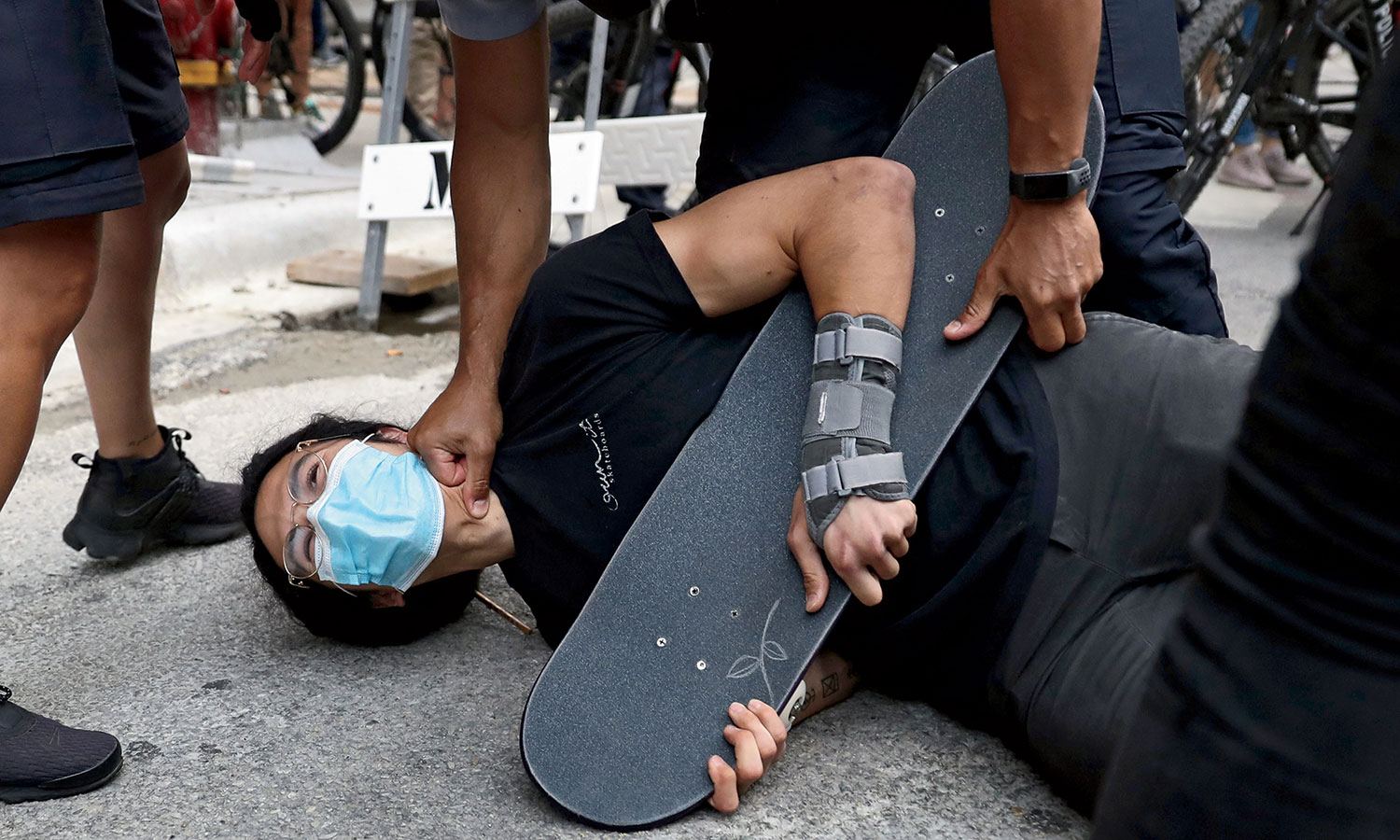When the protests in the wake of George Floyd’s killing came to Chicago in late May, I felt like I needed to be there. I worried about potential clashes between protesters and police, especially in a city with a long, troubled history surrounding its law enforcement. Having a reporter documenting events in real time would add a layer of accountability.
I went without an assignment from any media outlet, at least initially. I would just write about what I saw and post that and videos and photos on my Twitter feed. Though I had been a staff reporter for Block Club Chicago, I left that job a year ago to finish my journalism degree at DePaul University. I was not your ordinary undergrad. For one thing, I’m 29. And I spent five years in the Marine Corps, in the mechanized infantry, before getting out in 2017, as a sergeant, and pursuing journalism. I was in the middle of my finals, in fact, about to graduate, but reporting on the protests seemed more important.
When I left my apartment that Friday, I had no idea I would be witnessing a war between a city and its police force. By the end of that weekend, I had seen moments that inspired me as a Chicagoan — moments that made me feel like the protests might lead to real changes. But I had also witnessed wanton acts of violence, rage, and destruction by both protesters and police. I watched my city burn and its stores looted, often while officers helplessly looked on from just blocks away. I saw police in riot gear descend upon Chicago’s neighborhoods, armed with weapons that the government issues to Marines in war zones. Some nights, because of the violence and destruction, I didn’t recognize places that had once been familiar to me.
I’ve tried to make sense of everything that happened in those first days, to wrap it up neatly with a bow. But the more I process the events, the more I realize the futility. Instead, I’ll just share with you what I remember most — the images and scenes that have stuck with me from one of the most chaotic yet pivotal weekends in Chicago’s history.
Friday, May 29
The Spark
I’ve covered many protests in Chicago, and they tend to follow a pattern. Participants rally at a central location (usually Federal Plaza) for an hour, then march along a police-approved route. Streets are often blocked off ahead of time, and the demonstrations cause a minor inconvenience for a couple of hours.
When I arrived downtown that Friday evening, it was clear from their raw anger that protesters would not be content with that version of events. It felt like they were looking to cause a disruption. As participants marched throughout the Loop, I watched some sprint ahead to break through still-forming barricades of bike cops, who were hoping to funnel demonstrators to streets where they could be controlled. Whenever protesters got to these spots before the cops, that seemed to energize the crowd. People marched with even more vigor, cutting off traffic. But police began to adjust, beating demonstrators to barricade points more often than not. And when a dozen of the march leaders ended up trapped behind a barricade, I witnessed the first of what would be many physical clashes between police and protesters.
I remember being struck by the unbridled fury of the demonstrators. I’m used to the occasional “Fuck the police” or the middle finger being directed toward cops at protests. I was not used to watching dozens of Chicagoans screaming “Fuck 12!” just inches from the faces of armed officers. Witnessing some participants throw items, from water bottles to rocks, at cops, even spitting on them from just a few feet away, was jarring. That and seeing dozens of young activists hurl themselves through a wall of police on bikes to collect their fellow protesters made me realize we were on the cusp of something different.
I saw an unfamiliar look in the eyes of the officers, too. They appeared more on edge than usual, standing with a more aggressive posture than I was used to at protests. They, too, must have sensed things were different this time. Anyone present surely grasped that the city wasn’t prepared for the larger action planned for the next day.
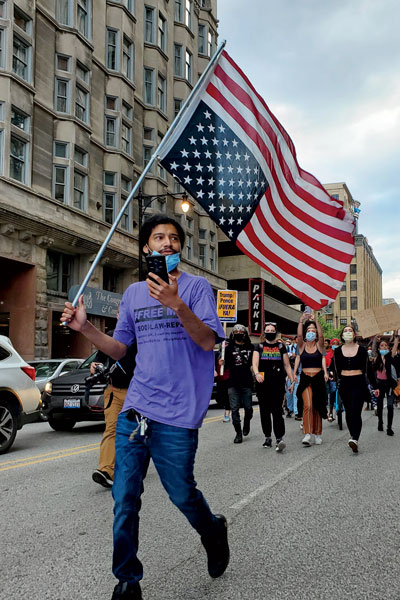
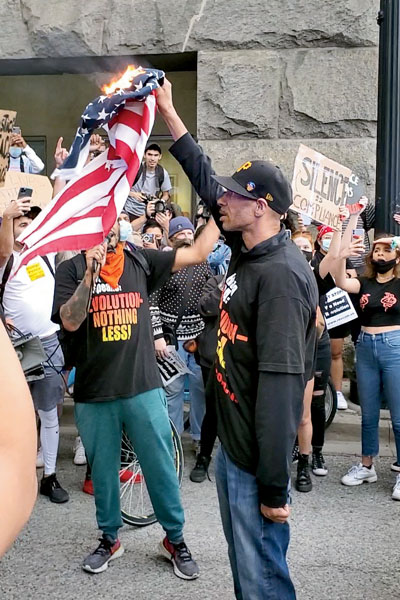
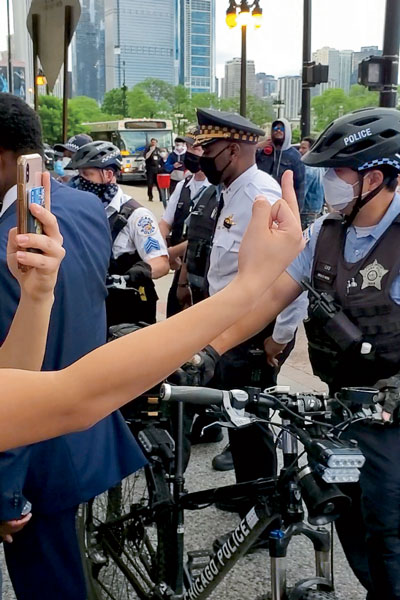
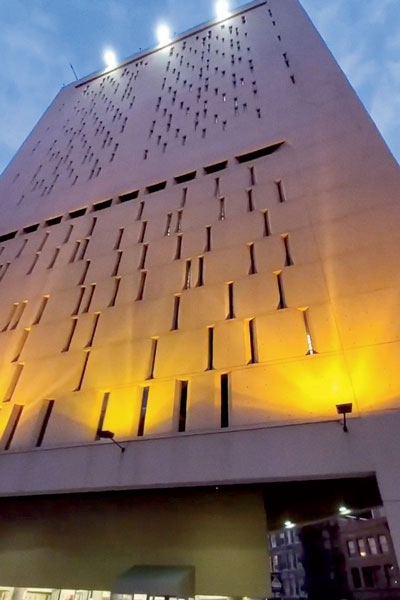
I will never forget watching a Black man, who looked to be in his 40s, standing on Ida B. Wells Drive (renamed last year to honor the influential Black journalist of the late 19th and early 20th centuries) and burning an American flag no more than three feet from a wall of police officers. I had never before witnessed a flag burning. It was a shock to the senses. As a Marine, I was taught love and reverence for the flag early and often — you could write a dissertation about the many rules of the flag-handling code.
I posted a video of the flag-burning on Twitter, and the comments included such language as “un-American,” “thugs,” and “That’s out of line!” Some commentators called for him to be jailed or arrested. One said that “we should drop him off in Africa.” Another asked if the protesters would be “willing to renounce their citizenship.”
But as I watched that flag burn, I had a much different reaction: I felt proud. The very idea of America is built on freedom, the thing I had sworn to defend as a Marine. And here I was watching an ultimate expression of that freedom: a Black man burning the country’s most sacred emblem at the feet of law enforcement, presumably without consequence.
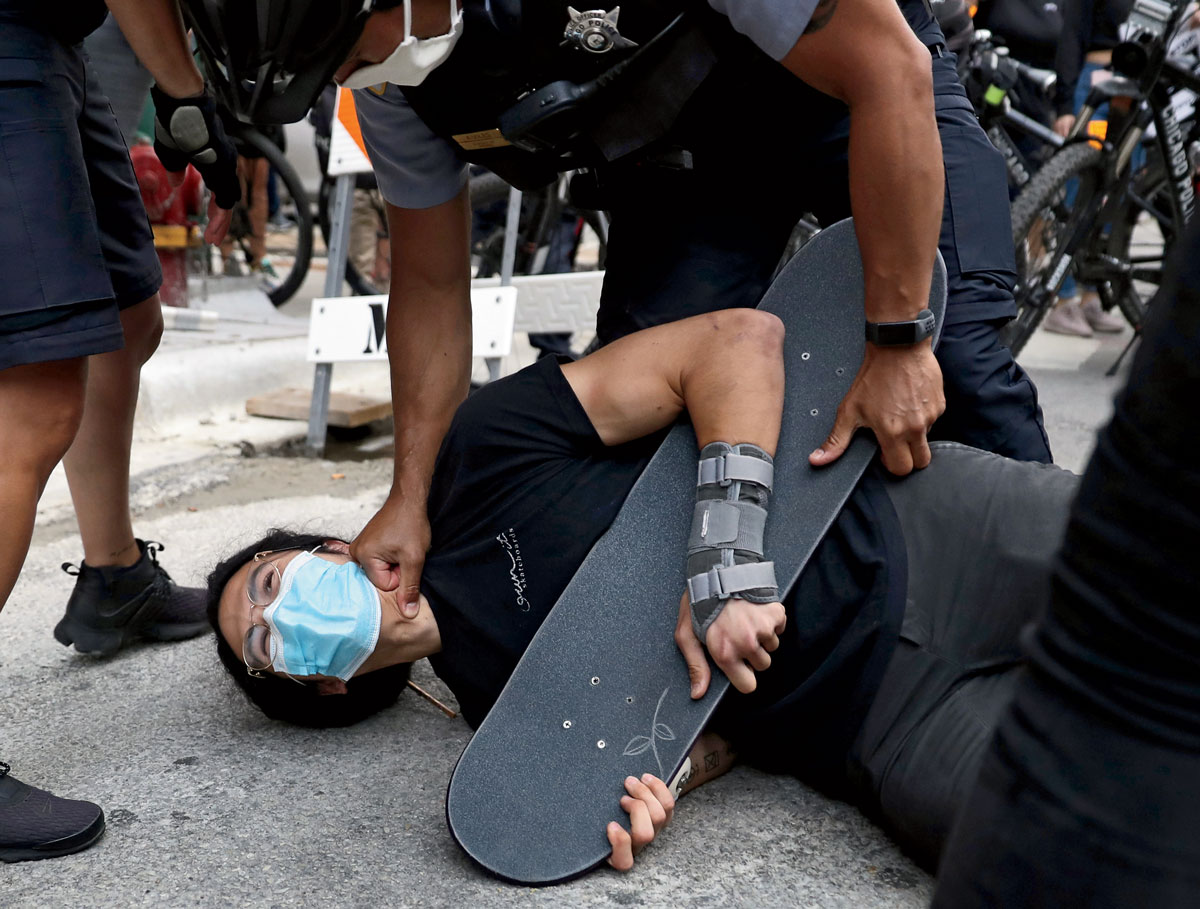
In a way, it was one of the most patriotic acts I had ever witnessed. That man burned the flag because he believes in a better America. He burned the flag because he is standing up against hundreds of years of oppression and police brutality. That hit home with me. Although I look and often identify as white, I am a tribal member of the Pokagon Band of Potawatomi Indians, the original stewards of Chicago long before Jean Baptiste Point du Sable showed up. The history of America is one of repression for my ancestors, too.
Toward the end of that first night, the protesters reached the Metropolitan Correctional Center, which, because its Brutalist architecture blends with its surroundings, hides a federal prison in plain sight in the Loop’s south end. By now the crowd had grown into the hundreds. Tensions were high, but organizers were able to placate the increasingly angry group.
The protesters made their way up the steps of the prison and banged on the glass until police swarmed in, pushing them back to the street. I was circling the building, trying to get different photos of the action, when I heard a small tapping sound coming from above. As the noise continued to grow, one of the protesters and I realized simultaneously what was happening: The prisoners were tapping on their windows to acknowledge the demonstrators.
“Hey, listen, everyone!” that protester screamed. “Do you hear that? They are cheering for you.”
A response chant of “We love you! We love you!” soon rose up among the crowd. The tapping got even louder. It seemed to be coming from every room inside the concrete fortress. The prison windows are opaque slits, so I don’t know if the inmates could see the protesters. But their tapping, along with the lights that began to flicker on and off, made it clear they could hear them.
That memory of standing on Clark Street under a physical symbol of mass incarceration, among hundreds of Chicagoans desperate for a change to our justice system, is something I will carry with me for the rest of my life.
Not sure if you can hear…but the people locked inside the correctional center are banging on the walls like crazy. #chicagoprotest pic.twitter.com/e4bMxtiAh9
— Jonathan Ballew (@JCB_Journo) May 30, 2020
Saturday, May 30
The Eruption
As I laced up my boots and packed my bag the next day, I felt like a Marine again for the first time in years. I had gone through my gear checklist, made a plan for how I would travel (parking just outside the Loop and walking in), and written on a card the phone numbers, in case I was arrested, of a lawyer and of the editors who had seen my tweets and were now giving me assignments.
I was expecting maybe 500 people or so at the start of the Saturday protest, but judging by the tips coming in to me by text and Twitter and the dozens of car caravans descending on the Loop, it quickly became clear the crowd was going to be larger. When I arrived at Federal Plaza at 1:30 p.m., 30 minutes before the protest was to begin, and saw demonstrators in the thousands, I knew the day would be a historic one.
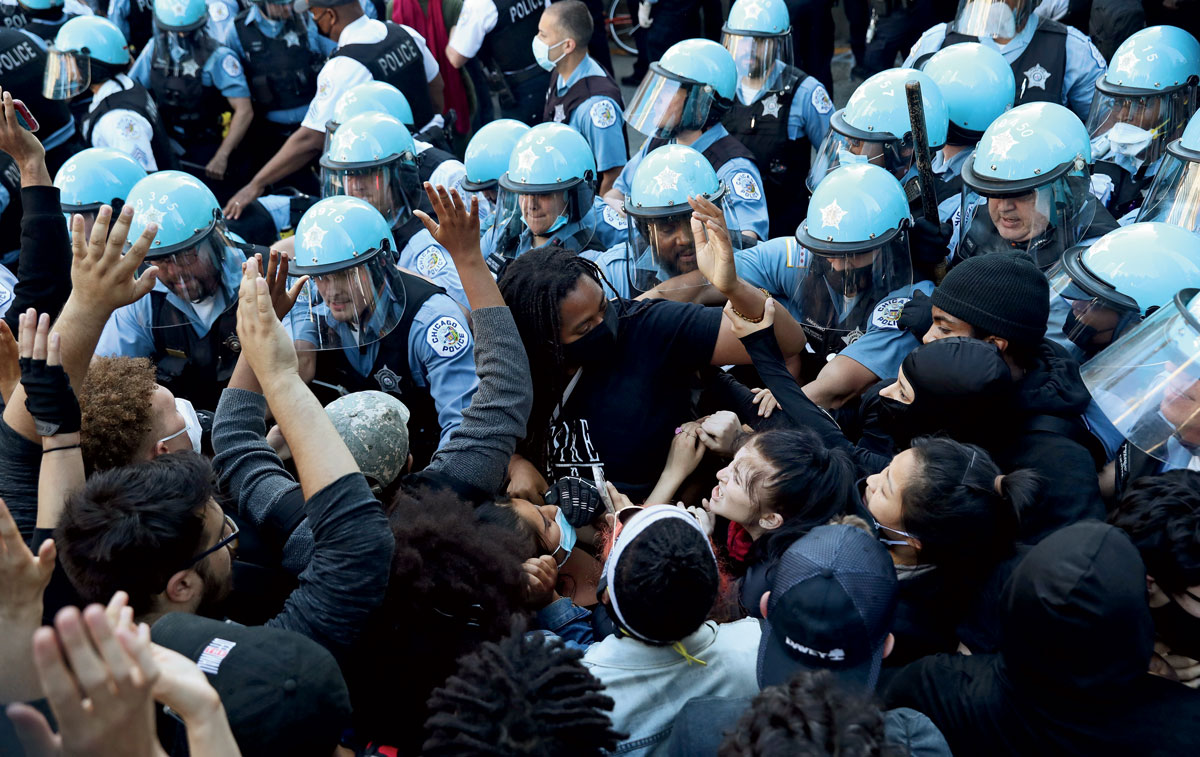
The sheer number of people made the demonstration far too big to be confined to Federal Plaza. They spilled into Dearborn Street as the air filled with nonstop honking from cars. Unlike the day before, the police were ready to handle confrontation. They carried nightsticks and zip-tie handcuffs, and many were dressed in riot gear, with body armor and face shields. Some were on bikes, some on foot, but their demeanor had markedly shifted to a certain stiffness. They seemed more focused. Protesters walked by hurling insults and profanity at them, and they just looked on with a thousand-yard stare.
It was as if Chicagoans were ready to hold a public forum on the entire history of policing in this city. Yes, this protest was about George Floyd. But it was also about Laquan McDonald, Hadiya Pendleton, and Rekia Boyd. It was about decades of abuse from officers like Jon Burge. That Saturday felt like a reckoning.
Almost as soon as the march began, the scene became chaotic. I don’t know if it was planned, but the police liaison — a woman in a neon vest who was coordinating with the organizers — and the marchers did a loop around Federal Plaza. The crowd had grown so large that the head quickly met the tail, and it was impossible to know where the leaders were or even what direction the march was headed.
Thousands of angry Chicagoans were looking for an outlet to express their rage and grief but had nowhere to go. The response by police seemed random, with walls of cops popping up at intersections around the John C. Kluczynski Federal Building. It became clear that things were turning dangerous when protesters started spray-painting “Fuck 12” on the building. Eventually, police swarmed the structure and formed a defensive line as protesters converged on them. Before long the police were outnumbered, and I could feel tensions growing. The police must have felt it, too, because they abandoned the Kluczynski building, presumably to regroup at a safer location. But angry protesters followed them. No matter where the cops turned, they found themselves surrounded.
Soon small skirmishes broke out between protesters and cops. The conflicts were mostly a lot of shouting and pushing, but on a few occasions both cops and protesters ended up on the ground. I could see that police had adopted a divide-and-conquer tactic, splitting the crowd into smaller groups in different areas downtown.
By the time I made it to Trump Tower, around 4 p.m., things were unruly. The rest of the day would follow the pattern I saw there: protesters becoming boxed in by police lines, and tensions rising until clashes broke out. I arrived just as protesters were jumping on top of two squad cars, smashing out their windows and spray-painting graffiti on them.
I don’t know if it was because I was behind the lens of my phone, trying to document what I was seeing, or if I just went into survival mode, but that hour under Trump Tower still doesn’t feel real. It is one thing to watch a clash between protesters and police on TV, but quite another to see it up close. While the demonstrators had cops greatly outnumbered, the police had training and the option to use force. I watched police beat a protester with a baton and take him away, screaming, in zip ties. I watched protesters in ski masks shatter police cruiser windows with a skateboard.
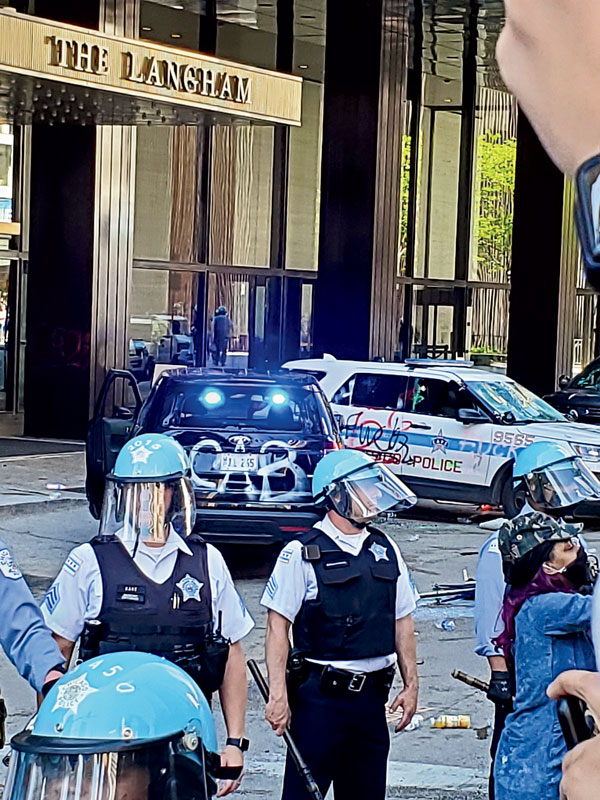
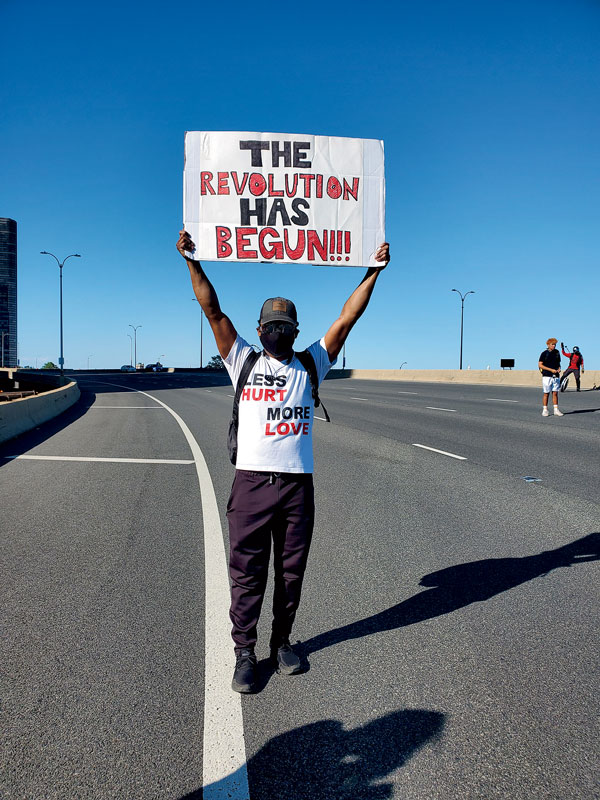
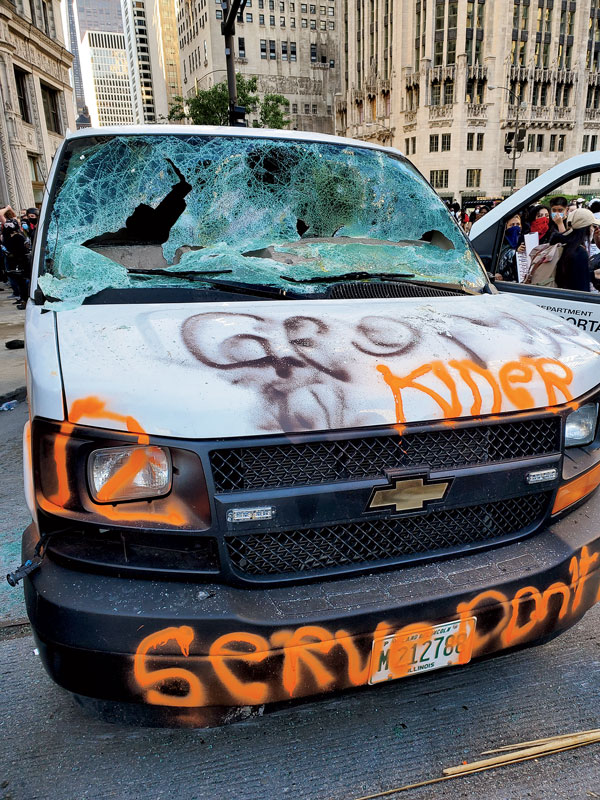
As protesters threw projectiles at them, police pushed the demonstrators farther into a chokepoint. Soon, I was smashed into by a wall of police, who were ordering us to move back. I yelled that there was nowhere for us to go. We were being sardined into a brick road partition, so we pressed back against the police. For the first time that day, I felt trapped and helpless.
When the crowd began to push out of the Trump Tower area, crossing the Wabash Avenue Bridge, I was surprised to see protesters forcing some police to retreat as well. I watched a squad car, with a crowd chasing it, going in reverse at what looked to be around 35 miles an hour. One young woman barely avoided being run over.
By 6 p.m., authorities had lost control of the Loop. As a reporter, I was seeking out areas where violence might erupt. And along Michigan Avenue, near Pioneer Court, it happened again. A group of at least a thousand protesters had become trapped by police in about a three-block stretch. The bridges had been raised, preventing them from going south, and a large wall of police blocked them from heading north up the Magnificent Mile.
The protesters’ anger at being cornered was palpable. During the next hour, I watched them destroy a city vehicle, bashing out the windows, slashing the tires, and trying to light it on fire. I saw them smash a WGN-TV news van and attempt to steal a TV camera propped up near it. The news crew arrived in time to grab the camera back and flee in the mangled van. As I walked up and down the line between police and protesters, I dodged projectiles, including a brick, hurled by demonstrators. Several times within that hour, tensions erupted into physical violence. One protester beat an officer with a metal pipe; another officer used a baton to hit an older woman who had hurled her body through the front lines.
It wasn’t until the riot squad showed up — cops with heavier body armor and face shields, armed with pepper spray, tear gas, and guns that shoot rubber bullets — that the police were able to regain control. The crowd was momentarily quelled by the arriving force. But once the police began deploying pepper spray, enraging anew the tired protesters, the rest of the night turned into a free-for-all.
There were moments when I understood, from a tactical standpoint, why police were deploying pepper spray. At times, only dozens of them were trying to control hundreds, if not thousands, of protesters. But other times, it seemed like they used it in retaliation or anger. Often the crowd would be complying with orders and the pepper spray would come out regardless. On multiple occasions, I had to scream “Press!” and hold up my pass to avoid being directly sprayed.
— Jonathan Ballew (@JCB_Journo) May 31, 2020
Driven from Michigan Avenue, the crowd headed for Grand and State, a few blocks northwest. I no longer recognized a once-familiar intersection. The protest had now devolved into a full-scale riot. Dumpsters were being turned over in the street, with lit M-80 fireworks tossed inside, making it sound like we were taking mortar fire. Guys on ATVs and motorcycles were doing doughnuts in the streets. Some people began breaking windows of businesses and defacing exteriors with spray paint.
The riot squad soon made its way to where most of this activity was happening. For a while, these officers formed a defensive line and just looked on, as though they were waiting for orders to move on the crowd. This was about the time the Dreadhead Cowboy showed up on his horse, energizing the throng. Soon after, the riot squad began to advance. As a former Marine, I could detect a change in the posture of the police. One officer, a rubber-bullet gun “at the ready” (pointed at a target, ready to be deployed), began advancing in a “combat glide” (a smooth way of walking that allows a person to accurately deploy a weapon while moving).
I was backing up as quickly as possible while simultaneously filming the scene with my phone and trying to avoid a horse, an ATV, and protesters. Suddenly the 50-meter gap between me and the police line had shrunk to 10 to 15 meters. When the officer with the rubber-bullet gun aimed directly at me from a distance that could be lethal, I realized I was in danger.
Holding up my bright yellow press pass as high as I could, I kept documenting what I was witnessing. I moved to the edge of the crowd to try to stay out of the way and continued to comply with the officers’ orders. Even so, even as most of the crowd and I retreated, police began to deploy their pepper spray. One officer — in an olive-green uniform, body armor, and a gas mask — looked directly at me. He sprayed at my face from maybe 10 feet away. I was able to shield a good deal of it with my forearms, but I was forced to run deeper into the crowd, momentarily abandoning my reporting, to wash my eyes out with water. Protesters offered me milk, but that is not effective — only water can give a little relief.
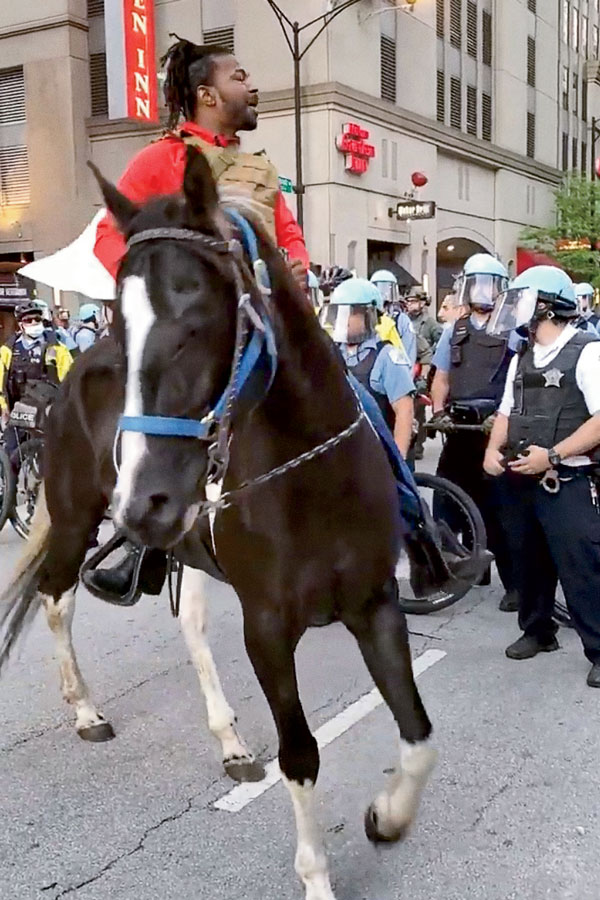
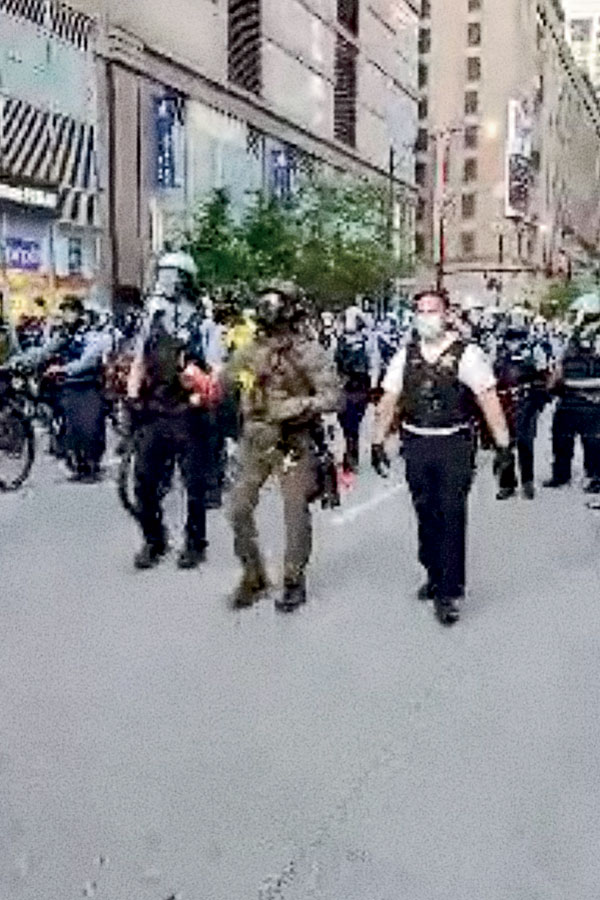
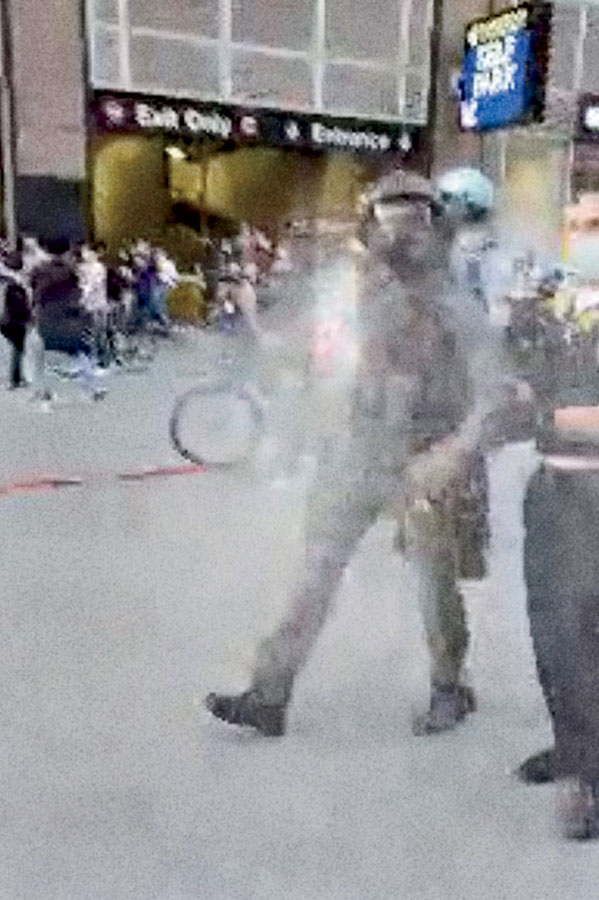
I had been sprayed during my Marine Corps training, so I didn’t panic because I knew the effects were temporary. Your eyes well up, and your nose suddenly wants to evacuate everything inside of it. It starts as a tingle and turns into a burning sensation. I was shocked I had been sprayed. There was no one else near me, I was complying with orders, and I had made it clear I was a member of the media. It felt like I had been targeted. (I’ve since filed a lawsuit against the City of Chicago and the as-yet-unidentified officer, alleging unjustified use of a chemical agent.)
Late that evening, downtown Chicago felt like something out of The Purge. There was little law enforcement present in some areas, while thousands of people filled Lake Street from Dearborn to Michigan. Soon shops were being vandalized and looted. There was no way to tell the protesters from the opportunistic new arrivals. It was a scene of pandemonium.
As I walked east along Lake, I saw a 7-Eleven with all its windows smashed. The sprinklers were going off, and dozens of people were flooding in and out, taking armfuls of merchandise — prepaid cellphones, cigarettes, booze. People threw lottery tickets into the air, and soon hundreds of them littered the streets.
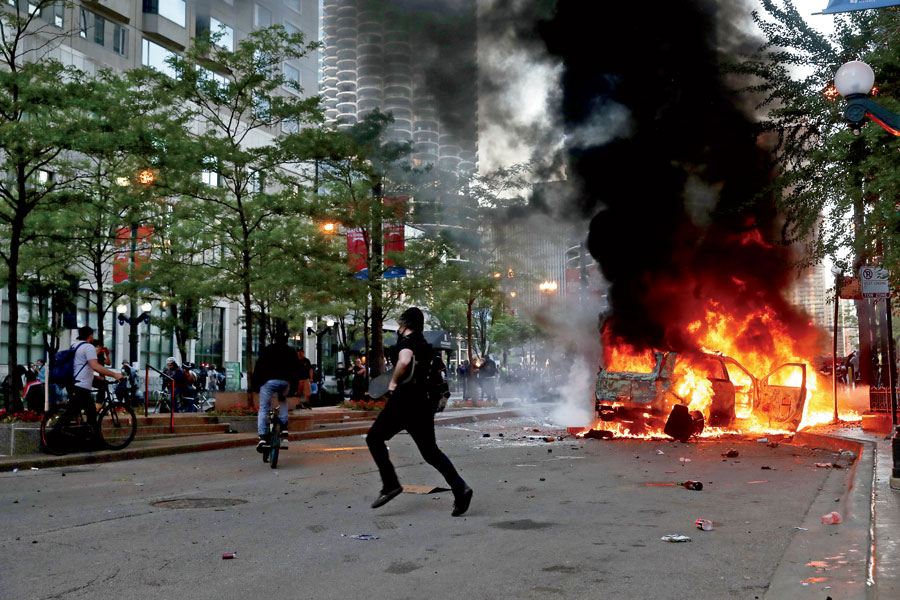
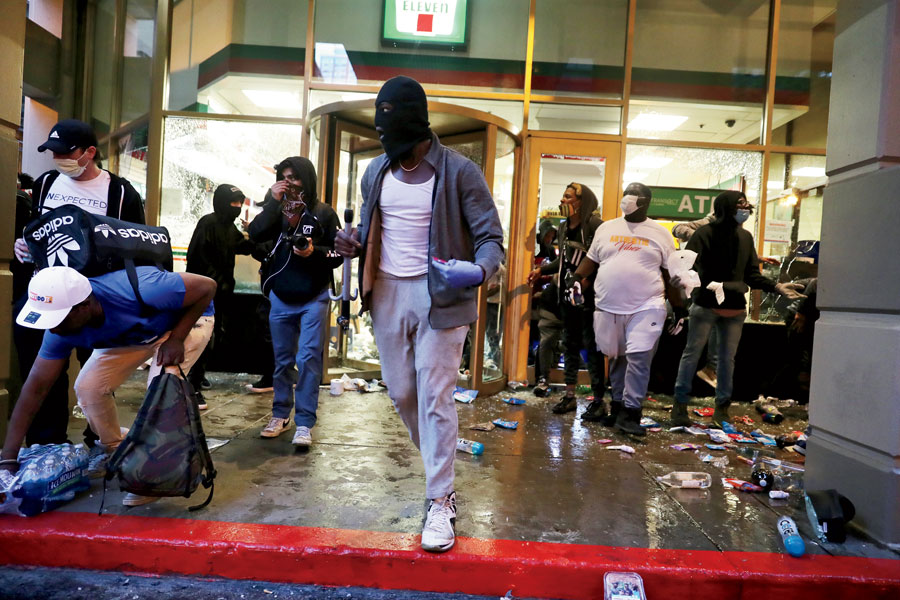
Along that stretch of Lake, it seemed as though every shop had been broken into. Even banks with shatterproof glass inside had their exterior doors and windows broken. Dumpsters and newsstand boxes had been dragged into the street and set on fire. Around midnight, I decided it was time to get home to safety.
I didn’t sleep that night, my arms and face burning from the pepper spray (taking a shower reactivates the chemical), my mind trying to make sense of what I had seen.
Sunday, May 31
The Aftermath
The next morning, it felt like the entire city was recovering from the events of the night before. I watched Mayor Lori Lightfoot’s press conference, where she was joined by the new police superintendent, David Brown, and the president of the Chicago Police Board, Ghian Foreman. After the day I had witnessed, I thought for sure we would hear a measured response from our leaders. Perhaps they would condemn the looting and rioting but also call out police actions that were inappropriate. Maybe they would acknowledge what seemed obvious to me: that the aggressive response had played a part in how Saturday had turned violent. Instead, what I heard made me uncomfortable, even angry.
All three officials had almost nothing but praise for Chicago’s police force, but scolded and chastised demonstrators. “This was not a First Amendment protest,” Brown said, but rather, “a synchronized strategy to loot, burn, and destroy.”
The terms “professionalism” and “textbook escalation” were used to describe the police actions. I was not surprised to hear such talk from the police superintendent, but seeing Foreman in lockstep was troubling. “I would not have had the same restraint that many of your officers showed last night,” he said to Brown.
To his credit, he did speak to the generational trauma inflicted on the Black community by police, but I balked at the fact that a man in his position — the head of the board that adjudicates police misconduct complaints — would make such a sweeping comment about police actions before any thorough investigation had been conducted. (It is ironic that later that day, Foreman was beaten by Chicago police officers, struck five times in the leg with batons, he said. He had been going for a walk when he got swept into a protest that he described as an “uprising.”)
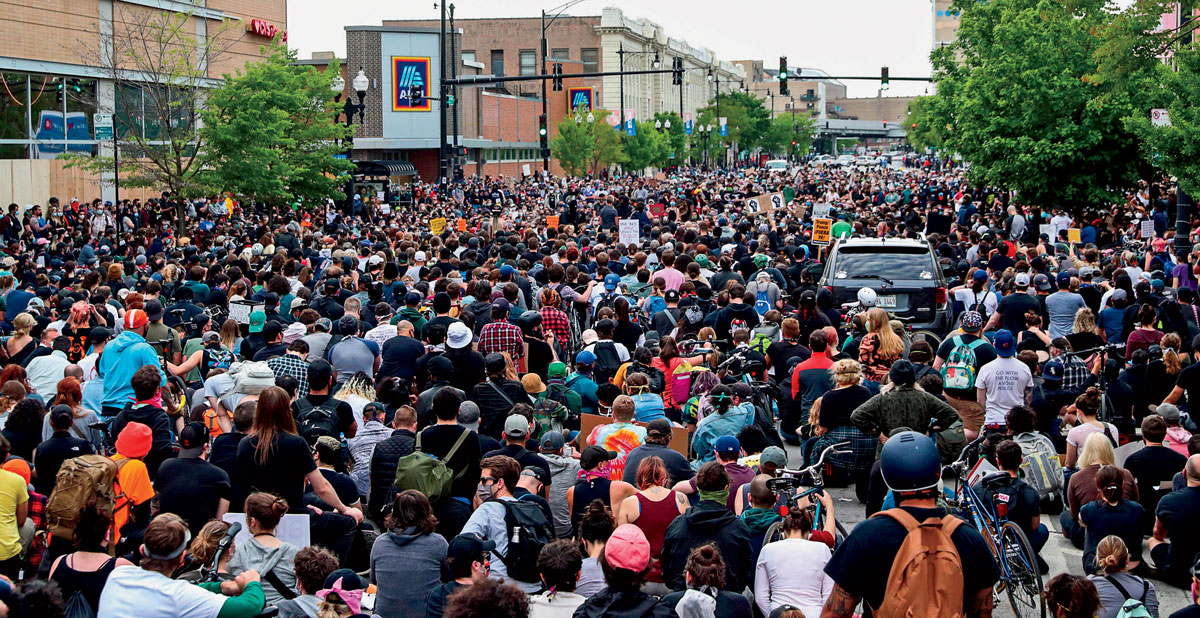
From what I had witnessed the day before, it felt like the city leaders were too quick to give the police a pass and were even placing them on a pedestal. I had seen dozens of officers hiding or covering their badges, which is against department regulations and has since been condemned by both the mayor and the police superintendent. (An investigation I did with the Chicago Reporter noted that 78 complaints were received by the Chicago Police Department regarding this practice.) I had seen officers beating people who had only accidentally been shoved into police lines by unruly crowds. I had seen officers deploying chemical agents when it seemed unnecessary. I had seen a police response that felt like a militarized assault, with aggressive tactics that arguably helped ignite the crowd.
That Sunday afternoon, as the protests continued, it appeared that authorities had decided to crack down even more. Bridges stayed raised, and the Loop was shut off to the public. Police were letting only essential workers and downtown residents and employees through barricades. With nowhere central for protesters to convene, Sunday, too, saw a night of rioting and looting, especially on the South and West Sides.
I drove south from the Loop down Halsted to the triple-digit-number streets, watching these neighborhoods experience the kind of destruction downtown endured the day prior. I saw business after business being looted. People were driving with almost no regard for traffic laws or speed limits. At one point, I saw an ambulance being chased by two cars, racing through an intersection to get away. No doubt a good share of the looting was opportunistic, but the rioting also seemed fueled by real rage, a message sent to the city from those fed up from being left behind.
By the time Sunday was over, the South and West Sides looked like a war-torn country. It seemed as though nearly every nonlocal establishment was destroyed. Some businesses were spared by putting “Black-Owned Business” or “Minority-Owned Business” signs in the windows. You could not walk down some streets without glass crunching under your shoes. City and state police, in their riot gear, and National Guardsmen dotted street corners. In some areas, coalitions of armed neighbors formed, ready to protect their homes and local businesses.
After covering a protest in Hyde Park, where demonstrators ended up stopping traffic on Lake Shore Drive, I drove around more that evening, documenting the damage, until about midnight, when I decided I’d seen enough.
Monday, June 1
The Homecoming
Monday evening, the biggest protest of the day was scheduled for my neighborhood, Uptown. While there was certainly a large police force present, its response was different from what I’d seen in the Loop on Saturday. This time, the thousands of protesters were allowed to gather on the main drag of Broadway, shutting down traffic for a couple of hours. When they marched, they were not corralled or divided into smaller groups by police. For the most part, officers watched the protest from the outskirts, rarely getting too involved. The demonstrators eventually marched to Lake Shore Drive, blocking traffic, but they remained peaceful.
That evening, though, when the 9 p.m. curfew took effect, the scene in Uptown changed almost immediately. Busloads of police soon dotted almost every corner, and their posturing was now aggressive. I was told to “get the fuck out of here” and “go the fuck home” by officers — until I showed them my press pass. Soon police started to make arrests, and for a while I filmed two Black protesters, who, already handcuffed when I arrived, were waiting to be taken to jail for what they were screaming was a curfew violation. Before I started filming, they were yelling out their names and birth dates (presumably in the hope that an ally would help bail them out), but I could not make out what else they were saying.
Most troubling was the group of five or six unidentified law-enforcement-looking men who were carrying aluminum baseball bats in the back of their body armor. Their uniforms read only “Officer” and had a shoulder patch that looked to be from a private security company. When I asked which law enforcement group they were with, they refused to answer and told me to “get lost.”
Although the scene in Uptown was not as chaotic as what I’d witnessed in the Loop or on the South and West Sides, I found walking through my neighborhood that night to be more distressing. There was something about seeing militarized police in front of my own neighborhood landmarks, places that are a source of comfort — like Jake’s Pup in the Ruf, a tiny joint with cartoon figures painted on the window — that felt particularly disturbing. Later, when I spoke to a Black colleague on the South Side, he told me he was not dealing with the same feelings I was. The trauma I was describing, he said, was something he had grown used to.
One thing that covering the protests made clear to me is that the relationship between a segment of Chicago and the city’s police force is perhaps fractured beyond repair. Nearly every protester I talked with wasn’t interested in reconciling with the police, whom they described as “pigs” “racist pieces of shit,” and worse. And most officers I spoke to described demonstrators as though they were enemy combatants, calling them “idiots,” “clowns,” or “animals.”
The wave of protests that swept the country, and the world, this spring has sparked a lot of talk about the need for a more equitable society. I can’t help but feel like another task force, another diversity panel, or another study on race isn’t going to cut it. I walked away from that first weekend of protests thinking that without real change — radical change — the toxicity will continue in Chicago.



